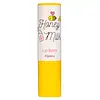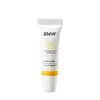What's inside
What's inside
 Key Ingredients
Key Ingredients

 Benefits
Benefits

 Concerns
Concerns

 Ingredients Side-by-side
Ingredients Side-by-side

Petrolatum
EmollientDiisostearyl Malate
EmollientMethyl Hydrogenated Rosinate
PerfumingCaprylic/Capric Triglyceride
MaskingRicinus Communis Seed Oil
MaskingMicrocrystalline Wax
Emulsion StabilisingOctyldodecanol
EmollientCetyl Ricinoleate
EmollientOzokerite
Emulsion StabilisingPolyethylene
AbrasivePhytosteryl/Isostearyl/Cetyl/Stearyl/Behenyl Dimer Dilinoleate
Skin ConditioningHydrogenated Vegetable Oil
EmollientDicalcium Phosphate
AbrasiveHoney Extract
HumectantMilk Protein Extract
Glycerin
HumectantPolyglyceryl-2 Triisostearate
EmulsifyingTocopheryl Acetate
AntioxidantWater
Skin ConditioningPropylene Glycol
HumectantPhenoxyethanol
PreservativeParfum
MaskingCI 19140
Cosmetic ColorantPetrolatum, Diisostearyl Malate, Methyl Hydrogenated Rosinate, Caprylic/Capric Triglyceride, Ricinus Communis Seed Oil, Microcrystalline Wax, Octyldodecanol, Cetyl Ricinoleate, Ozokerite, Polyethylene, Phytosteryl/Isostearyl/Cetyl/Stearyl/Behenyl Dimer Dilinoleate, Hydrogenated Vegetable Oil, Dicalcium Phosphate, Honey Extract, Milk Protein Extract, Glycerin, Polyglyceryl-2 Triisostearate, Tocopheryl Acetate, Water, Propylene Glycol, Phenoxyethanol, Parfum, CI 19140
Petrolatum
EmollientIsopropyl Palmitate
EmollientPolybutene
Caprylic/Capric Triglyceride
MaskingPentaerythrityl Tetraisostearate
EmollientPolyethylene
AbrasiveMicrocrystalline Wax
Emulsion StabilisingTocopheryl Acetate
AntioxidantButyrospermum Parkii Butter
Skin ConditioningSqualane
EmollientPanthenol
Skin ConditioningDiisostearyl Malate
EmollientAllantoin
Skin ConditioningSorbitan Sesquioleate
EmulsifyingPhenoxyethanol
PreservativeHydrogenated Vegetable Oil
EmollientPrunus Amygdalus Dulcis Oil
Skin ConditioningArgania Spinosa Kernel Oil
EmollientSimmondsia Chinensis Seed Oil
EmollientCamellia Sinensis Seed Oil
HumectantCamellia Japonica Seed Oil
EmollientOlea Europaea Fruit Oil
MaskingMacadamia Integrifolia Seed Oil
Skin ConditioningStearalkonium Hectorite
Gel FormingPropylene Carbonate
SolventCitrus Aurantium Dulcis Peel Oil
MaskingLimonene
PerfumingMonascus Extract
Skin ConditioningPalmitoyl Hexapeptide-12
Skin ConditioningTocopherol
AntioxidantWater
Skin ConditioningGlycyrrhetinic Acid
Skin Conditioning1,2-Hexanediol
Skin ConditioningSodium Hyaluronate
HumectantHydroxypropyltrimonium Hyaluronate
Hydrolyzed Hyaluronic Acid
HumectantSodium Acetylated Hyaluronate
HumectantHyaluronic Acid
HumectantPotassium Hyaluronate
Skin ConditioningSodium Hyaluronate Crosspolymer
HumectantPetrolatum, Isopropyl Palmitate, Polybutene, Caprylic/Capric Triglyceride, Pentaerythrityl Tetraisostearate, Polyethylene, Microcrystalline Wax, Tocopheryl Acetate, Butyrospermum Parkii Butter, Squalane, Panthenol, Diisostearyl Malate, Allantoin, Sorbitan Sesquioleate, Phenoxyethanol, Hydrogenated Vegetable Oil, Prunus Amygdalus Dulcis Oil, Argania Spinosa Kernel Oil, Simmondsia Chinensis Seed Oil, Camellia Sinensis Seed Oil, Camellia Japonica Seed Oil, Olea Europaea Fruit Oil, Macadamia Integrifolia Seed Oil, Stearalkonium Hectorite, Propylene Carbonate, Citrus Aurantium Dulcis Peel Oil, Limonene, Monascus Extract, Palmitoyl Hexapeptide-12, Tocopherol, Water, Glycyrrhetinic Acid, 1,2-Hexanediol, Sodium Hyaluronate, Hydroxypropyltrimonium Hyaluronate, Hydrolyzed Hyaluronic Acid, Sodium Acetylated Hyaluronate, Hyaluronic Acid, Potassium Hyaluronate, Sodium Hyaluronate Crosspolymer
Ingredients Explained
These ingredients are found in both products.
Ingredients higher up in an ingredient list are typically present in a larger amount.
This ingredient is an emollient, solvent, and texture enhancer. It is considered a skin-softener by helping the skin prevent moisture loss.
It helps thicken a product's formula and makes it easier to spread by dissolving clumping compounds.
Caprylic Triglyceride is made by combining glycerin with coconut oil, forming a clear liquid.
While there is an assumption Caprylic Triglyceride can clog pores due to it being derived from coconut oil, there is no research supporting this.
Learn more about Caprylic/Capric TriglycerideDiisostearyl Malate is an emollient and most often used in lip products. It comes from isostearyl alcohol, a fatty acid, and malic acid, an AHA.
As an emollient, Diisostearyl Malate helps create a thin film on your skin to trap moisture in. This helps keep your skin soft and smooth.
Hydrogenated Vegetable Oil is created by adding hydrogen to vegetable oil in order to give it more stability. This process also raises the melting point of vegetable oil. In cosmetics, it is an emollient.
Emollients help soothe and soften the skin. They do this by creating a protective film on your skin. This barrier helps trap moisture and keeps your skin hydrated. Emollients may be effective at treating dry or itchy skin.
The term "Hydrogenated Vegetable Oil" is an umbrella term and can refer to a variety of vegetable oils and blends of: sunflower oil, soybean oil, olive oil, coconut oil, palm oil, and more.
Due to the differences in vegetables, the benefits may vary.
Learn more about Hydrogenated Vegetable OilMicrocrystalline Wax is created by de-oiling petroleum. It is highly refined and purified before being added to cosmetics.
Microcrystalline Wax is used to enhance the texture and create even consistency. It helps stabilize a product by preventing ingredients from separating.
Petrolatum is more commonly known as petroleum jelly. It is created by mixing waxes and mineral oils.
This ingredient is effective at reducing water loss by 99%. This is because it is an occlusive. Occlusives create a hydrophobic barrier on the skin to prevent evaporation. This property makes it great for hydrating dry skin.
Pro tip: Use occlusives, such as this ingredient, on damp skin for the best results.
The quality or origin of petrolatum is only known when disclosed by the brand. Most cosmetic petrolatum has gone through several purification stages.
Another benefit of occlusives is it protects your skin against infection or allergies.
Petrolatum may not be safe for fungal-acne. Studies show mineral oil / petroleum leads to the growth of M. Furfur, a type of yeast.
Learn more about PetrolatumPhenoxyethanol is a preservative that has germicide, antimicrobial, and aromatic properties. Studies show that phenoxyethanol can prevent microbial growth. By itself, it has a scent that is similar to that of a rose.
It's often used in formulations along with Caprylyl Glycol to preserve the shelf life of products.
Polyethylene is a synthetic ingredient that helps the skin retain moisture. It is a polymer.
It is also typically used within product formulations to help bind solid ingredients together and thicken oil-based ingredients. When added to balms and emulsions, it helps increase the melting point temperature.
Tocopheryl Acetate is AKA Vitamin E. It is an antioxidant and protects your skin from free radicals. Free radicals damage the skin by breaking down collagen.
One study found using Tocopheryl Acetate with Vitamin C decreased the number of sunburned cells.
Tocopheryl Acetate is commonly found in both skincare and dietary supplements.
Learn more about Tocopheryl AcetateWater. It's the most common cosmetic ingredient of all. You'll usually see it at the top of ingredient lists, meaning that it makes up the largest part of the product.
So why is it so popular? Water most often acts as a solvent - this means that it helps dissolve other ingredients into the formulation.
You'll also recognize water as that liquid we all need to stay alive. If you see this, drink a glass of water. Stay hydrated!
Learn more about Water